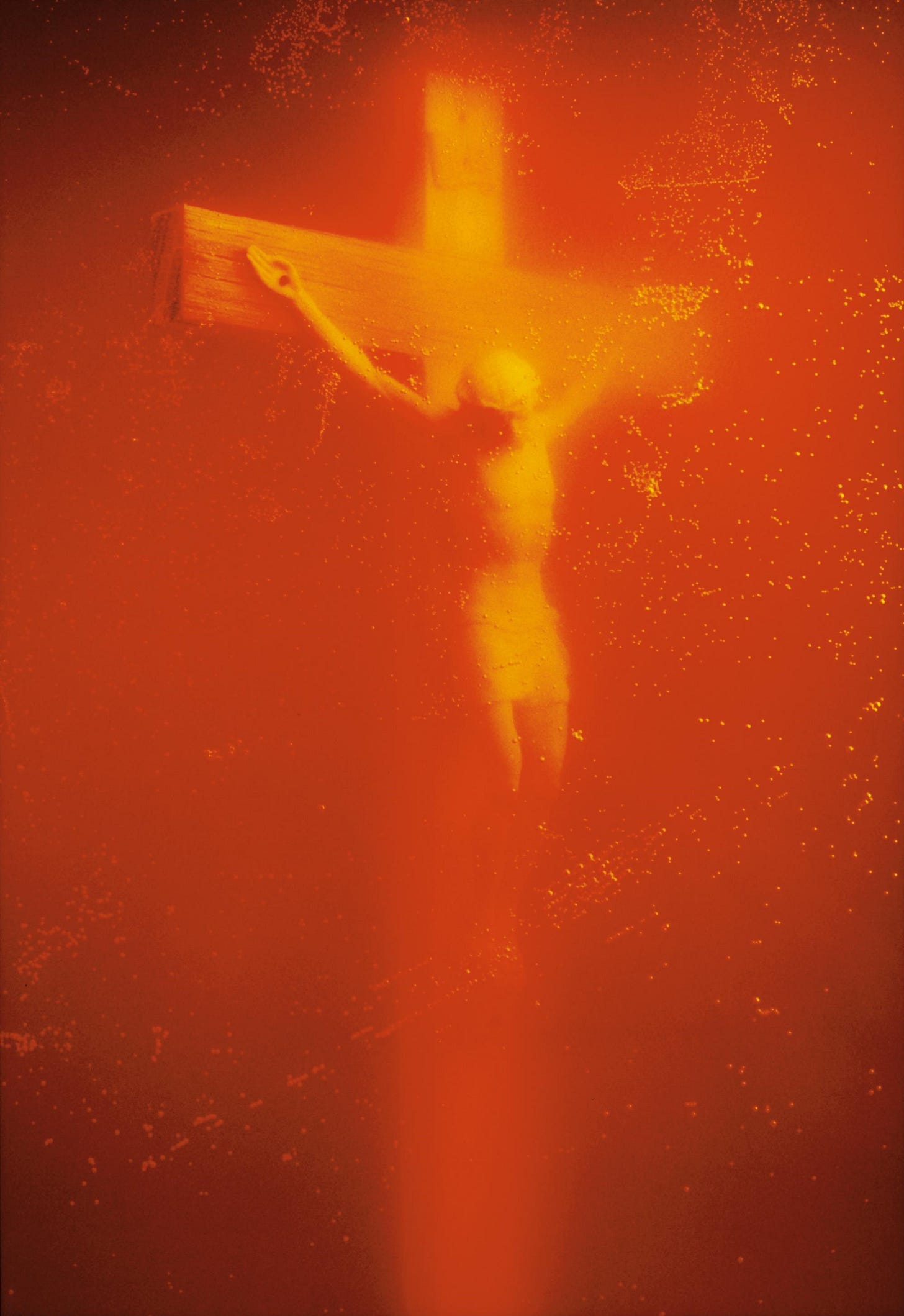With All Its Teeth: Sex, Violence, Profanity, and the Death of Christian Art is out today.
Have Christians settled for artistic bankruptcy? To understand Jesus and the Bible, you have to understand art. The art God creates and commissions comforts and encourages, and it disturbs and offends. What is art? Does it ever go too far? How should Christians understand, receive, and create it?
Joshua S. Porter presents a readable, literary, story-driven Biblical theology of the artistic and the obscene.
(Read a free sample below.)
PREFACE TO ACT I:
HOW CHRISTIANS DESTROY ART
I HAVE NO IDEA how it actually happened, but I have to assume the guy made a mess. It was all the way back in 1987. Photographer Andres Serrano submerged a small, plastic crucifix in a glass tank filled with his own urine. On the cross hung the familiar figure of Jesus, his impaled hands outstretched in misery. Serrano took a picture. He called it, Immersion (Piss Christ).
It's not something I’ve ever done—steeped something in a jar of pee just to take a picture of it—but I assume you can’t go peeing in a jar, dropping trinkets in it, then retrieving them without spillage. If you want to be an artist, you’ve got to make sacrifices, I guess. If you’re going to make people as upset as he did, you might as well work for it.
More than twenty years later, four individuals wearing sunglasses entered a French museum carrying a hammer inside a sock. They made a different kind of mess.
Between those two moments—the one with the jar of urine and the one with the hammer inside a sock—Piss Christ had become the subject of predictable, ongoing outrage. Former United States Senator Alphonse D’Amato called the photograph “shocking, abhorrent and completely undeserving of any recognition whatsoever.” In 1997, the Catholic Archbishop of Melbourne was so bothered by it that he sought an injunction from the Supreme Court of Victoria to stop Piss Christ from being displayed in Australia’s most visited art museum.
Then, after all those years and protests, four individuals in sunglasses entered a French exhibition where Piss Christ was displayed. It was Palm Sunday, a day when Christians remember Jesus’s celebrated entry into Jerusalem before he was executed. The four visitors in sunglasses assaulted the guards on duty, drew a hammer from a sock, and in the ensuing scuffle, managed to smash the Plexiglas that protected Piss Christ before using a sharp implement to slash the photograph beyond repair. Their work complete, the vandals fled the scene. When the press wrote about it, they called the criminals “Christian protestors.” This is one way that Christians destroy art, but not the only way. They do it all the time.
The French gallery was eventually re-opened with the destroyed artwork on display just as it had been before Palm Sunday. The newly modified Piss Christ became an inadvertently poignant spectacle. The alleged Christian criminals had (by intention or coincidence) driven their angry hammer directly into Jesus’s face. Blemished by a violent crater, the visage of Christ erupted with splintering fissures and shattered glass. It was just as the prophet Isaiah had predicted: there were many who were appalled at him— his appearance was so disfigured beyond that of any human being and his form marred beyond human likeness.
Following the incident on Palm Sunday, Andres Serrano—the artist responsible for Immersion (Piss Christ)—described the indignation constantly circling his piece like an angry buzzard as “a misinterpretation.” He said, “I am a Christian, and a Christian artist.” What does it mean to be a Christian artist? If Serrano is a Christian artist, does that make Piss Christ a Christian work of art? If so, why would other Christians want to destroy it?
When beholding Piss Christ, another Christian—Catholic nun, Sister Wendy Beckett—found the image powerful and moving, deriving from it a strong sense of conviction. “I thought [Serrano] was saying... this is what we are doing to Christ. We are not treating him with reverence... We live very vulgar lives. We put Christ in a bottle of urine—in practice. It was a very admonitory work... But I think to call it blasphemous is really rather begging the question: it could be, or it could not be. It is what you make of it, and I could make something that made me feel a deep desire to
reverence the death of Christ more by this suggestion that this is what, in practice, the world is doing.” Sister Wendy saw the same photo as the Christian vandals and, like them, found it vulgar. But, in Sister Mary’s mind, the spectator is reprimanded by the vulgarity of the piece. The vulgar life, which treats the sacrifice of Jesus with contempt, also desecrates that sacrifice. It puts Jesus in a jar of urine.
Others interpreted the image of Jesus submerged in urine as a commentary on the cheapening of sacred symbols. The domestication of the crucifix. Instrument of torture as decorative flourish. "The thing about the crucifix itself is that we treat it almost like a fashion accessory. When you see it, you're not horrified by it at all, but what it represents is the crucifixion of a man," Serrano said of his work. "So if Piss Christ upsets you, maybe it's a good thing to think about what happened on the cross."
But the image is more than its ideological agenda. As a moment captured by a camera and committed to film, formal qualities of style, composition, and lighting factor in how it is beheld and ununderstood. Art critic Lucy Lippard admired the piece, calling it a "darkly beautiful photographic image... The small wood and plastic crucifix becomes virtually monumental as it floats, photographically enlarged, in a deep rosy glow that is both ominous and glorious." What, if anything, does the shape and hue of the Piss Christ have to do with what it does or doesn’t mean to say? If you follow the paper trail, Piss Christ seems to mostly (or only) upset people who claim to be Christians, and that on the basis of their Christianity itself. But Piss Christ was created by someone who describes himself as a Christian artist. Some Christians argued that Piss Christ created in them a deep desire to regard Jesus with more reverence, not less. That it compelled them to worship. For them, it was the ugliness of the image that somehow instilled reverence, though others beholding the same image regarded its visual composition—apart from its theological implications—as not ugly, but “beautiful” and “glorious.”
Does Piss Christ go too far to make a point unsurprisingly lost on most of its audience? Is such a notoriously offensive image defensible? If this work is indeed blasphemous in any way, is it wrong for Christians to look at it? To admire it? If the artist had intended to defile the image of Jesus with his work, would Sister Wendy Beckett be wrong to infer from the image a meaning the artist did not intend and be drawn to worship just the same? Given the unavoidably incendiary nature of the image and its title, does the artist owe the audience an explanation? After all, if he is a Christian, and if the work is potentially blasphemous, shouldn’t he clear the air, lest some of his fellow Christians be led astray? And really, is a work of art really worth all this controversy? If Andres Serrano had wanted to make a statement about the vulgar cheapening of Jesus’s sacrifice, why not do it in a way less likely to attract protesters with hammers? With a title like Piss Christ, anyone could have foreseen scandal on the horizon, especially a Christian.
This is a book about all those things.
Some people who read this book might be artists and art enthusiasts. The painters, the musicians, the novelists, the sculptors, designers, illustrators, filmmakers, singers, dancers, and on down the list. Some readers, by wiring or nature or upbringing or happenstance, deeply admire the craft, though they may not be artists themselves. For both the artist and art enthusiast, the arts are indispensable—an important and necessary means through which they process reality. For them, vocation, calling, and even identity itself are all irrevocably tethered to art and creativity.
But maybe some people who read this book think of themselves as unfriendly to the arts. Hostile to them. For them, art is, at best, inessential and at worst, dangerous, misleading, and destructive. But most of the people reading this book probably sit somewhere between the two extremes, leaning toward enthusiast or cynic, depending on context and genre. For them, art is not a way of life, per se, but it is fine and good. They enjoy music playing in their cars, streaming movies and miniseries, even decorative flourishes in their homes. Maybe they’ve been particularly moved by something creative from time to time, and they can certainly imagine the same thing happening to someone else. If you are the minority fixed at either pole—the art enthusiast or deprecator—most of the people you know are in the middle: Enthusiastic, indifferent, or cynical. Depending.
Within that wide spectrum, there are Christians. There are disciples of Jesus who love art, who create art, who need art. There are disciples of Jesus who regard art with skepticism or contempt. There are disciples of Jesus who don’t think of themselves as art lovers or haters, who haven’t really given it a lot of thought one way or another. And, like many, they lean to either extreme from time to time. One Christian might find themselves in profound awe of art and creativity when hearing a beautiful worship song. That same Christian might, however, find themselves skeptical and disapproving of the arts when beholding Piss Christ. This is a book for all of you.
For every one of us, art is inescapable. Today, you will be inundated with visuals, designs, screens, music, video, and photographs. You will wear clothes, use furniture, eat food, behold advertisements that—good or bad, well-made or shoddy—were all birthed from some creative process. Though our access to art and the mediums for creating it have evolved over time, art and creativity are not new. They are as old as anything can possibly be.
And almost as old as art itself is the way we destroy it.





I just had a vision of myself eating this book as performance art--after I read it of course. Seriously though, it’s on its way to my mailbox (though unfortunately delayed 🫤) and I can hardly wait!
This is going to be a great read. I love art and have always wondered why Christians make crap art or hate it? It’s like a minority of Christians appreciate art.
Also, I’m concerned for the artist who made Piss Christ. His urine is almost too dark.